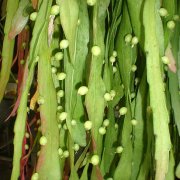Care of the indoor plant Disocactus flagelliformis or Rattail cactus |
|
The genus Disocactus now includes the genus Aporocactus and Nopalxochia (among others) and includes 15 species of epiphytic cacti native from Mexico, Central America, and some regions of South America. Some species are: Disocactus flagelliformis, Disocactus alatus, Disocactus martianus, Disocactus phyllanthoides, Disocactus ramulosus. Common names: Rattail cactus, Rat's Tail Cactus, Whip Cactus. This species is native to Oaxaca and Hidalgo, Mexico. They are hanging cacti that in their natural environment behave like epiphytes living on trees. The long stems are cylindrical, have aerial roots and 12 spiny ribs on the areoles. They produce pink or red flowers, 8 cm (3.14") long, emerging from the stems. Rattail cactus is used as indoor hanging plants or for terraces and balconies in places sheltered from the cold. Disocactus flagelliformis needs semi-shade exposure and temperatures above 10 ºC (50 ºF); it can withstand cold (not frost) but suffers stem damage. The soil can be a normal commercial substrate to which 1/3 of peat or leaf mulch is added. The best time for transplants is just after flowering. Water abundantly in summer and reduce watering the rest of the year but without the substrate drying out completely. Fertilize during the summer, every 15 days, with mineral fertilizer for cacti. Whip Cactus does not need pruning. Disocactus flagelliformis is a plant prone to mite attack. Rat's Tail Cactus propagates by seeds and by cuttings from the tip of the stem in summer. |
Images of the indoor plant Disocactus flagelliformis or Rattail cactus |
Find plants
Disocactus flagelliformis or Rattail cactus | Care and Growing
© 2025 FavThemes






